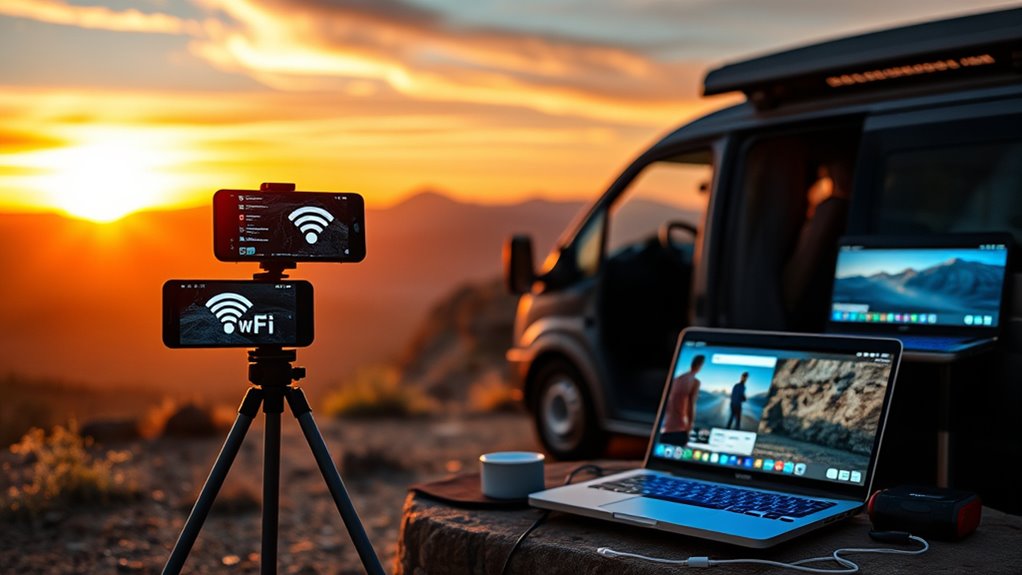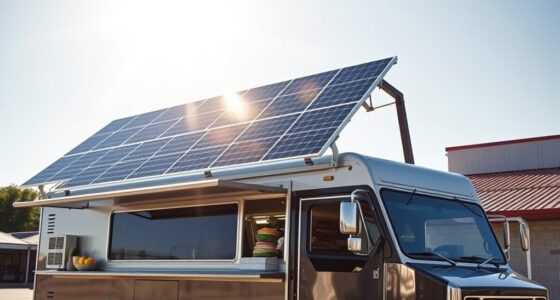To guarantee reliable internet on the road, combine satellite connectivity for remote areas with mobile hotspots for urban and semi-urban zones. Keep backup SIM cards from multiple providers and use signal boosters or portable antennas to enhance weak signals. Planning ahead by checking coverage maps helps you find strong signals, while investing in quality equipment boosts performance. Want to discover more ways to stay connected no matter where you go? Keep exploring to learn additional strategies.
Key Takeaways
- Combine satellite internet with mobile hotspots for comprehensive coverage in remote and urban areas.
- Use signal boosters and portable antennas to improve weak signals and enhance connection stability.
- Keep multiple SIM cards from different providers to switch networks and maintain connectivity.
- Research coverage maps beforehand to identify areas with strong signal availability.
- Invest in high-quality, future-proof equipment supporting LTE and 5G for faster, more reliable speeds.

Having reliable internet while on the road can transform your travel experience, making it easier to work, stay connected, or enjoy entertainment without interruption. One of the most effective ways to achieve this is through satellite connectivity. Unlike traditional cellular networks that depend on cell towers, satellite internet uses orbiting satellites to beam internet signals directly to your device or a dedicated dish. This means you can access high-speed internet in remote areas, wilderness, or places where cell coverage is weak or nonexistent. Satellite connectivity has improved markedly over the years, offering faster speeds and lower latency, making it suitable for streaming, video calls, or remote work. It’s especially beneficial if you frequently travel to rural locations or venture off-grid, where cellular signals might be unreliable or unavailable.
Complementing satellite connectivity are mobile hotspots, which are portable devices that create a personal Wi-Fi network using cellular data. These gadgets allow you to connect multiple devices—laptops, tablets, smartphones—simultaneously, ensuring everyone stays connected. Mobile hotspots are incredibly versatile; you can carry them in your bag or pocket and set them up within minutes. They work with existing cellular networks, so their reliability depends on the strength of local coverage, but they can be a lifesaver in urban or semi-urban areas where cellular signals are strong. Many mobile hotspots support multiple LTE bands or even 5G, providing faster speeds and more stable connections. Some models also feature built-in antennas or signal boosters to enhance performance in areas with weaker signals, ensuring you get the best possible internet experience wherever you are.
To maximize your connectivity, consider a hybrid approach that combines satellite internet for remote or rural areas and mobile hotspots for everyday use in cities or towns. This strategy offers flexibility and redundancy, ensuring you’re never left without internet. Additionally, always keep backup options like SIM cards from different providers or portable antennas, which can help improve your signal strength when needed. It’s also wise to research coverage maps before your trip, so you know where satellite and cellular signals are strongest. Investing in quality equipment and staying updated on the latest technology can make a considerable difference in maintaining a stable connection on the road. High-speed satellite internet has become more accessible and reliable, making it a valuable option for travelers seeking consistent online access. Whether you’re working remotely, streaming movies, or simply staying in touch with loved ones, reliable internet is within your reach with the right tools and planning.
Frequently Asked Questions
What Are the Best Mobile Hotspots for Frequent Travelers?
You should consider portable hotspots like the Netgear Nighthawk M6 or Verizon Jetpack, which offer strong signals for frequent travelers. Pair them with essential travel accessories like signal boosters to improve connectivity in low-signal areas. These devices are easy to carry, provide fast internet, and keep you connected on the go. Investing in reliable mobile hotspots ensures seamless internet access, making your travels smoother and more productive.
How Can I Extend My Wi-Fi Signal in Rural Areas?
You might hesitate, thinking rural internet signals are just too weak. But you can extend your Wi-Fi signal in rural areas by using signal boosters designed for low coverage zones. These devices amplify your existing internet, improving speed and stability. Pairing a reliable signal booster with a good router guarantees you stay connected even in remote locations, making your rural internet experience smoother and more dependable.
What Data Plans Offer Unlimited Internet on the Road?
You can find data plans offering unlimited internet on the road through providers like Verizon, T-Mobile, and AT&T, which often include plans with no data caps or high thresholds. Look for options that offer plan flexibility to adapt to your usage needs, especially if you’re frequently traveling. Always check the fine print for any restrictions or throttling policies, ensuring you get reliable, unlimited connectivity wherever your journey takes you.
How Do I Troubleshoot Connectivity Issues While Traveling?
When you face connectivity issues while traveling, start with network troubleshooting by restarting your device and toggling airplane mode. Check for signal interference from buildings or natural obstacles that might weaken your connection. Verify your data plan is active and has sufficient bandwidth. If problems persist, move to a different location, like a higher spot or open area, to improve signal strength. This proactive approach helps restore reliable internet quickly.
Are There Any Safety Tips for Using Public Wi-Fi Networks?
When using public Wi-Fi networks, you should be aware of public Wi-Fi risks and practice safe browsing habits. Avoid accessing sensitive accounts or entering personal information, and use a VPN for added security. Make sure your device’s firewall is active, and keep software updated. By staying cautious and following safe browsing practices, you can protect your data and enjoy internet access while traveling without compromising your safety.
Conclusion
To keep your internet connection steady on the road, it’s tempting to rely solely on smartphones or public Wi-Fi. But did you know multi-network SIM cards and portable Wi-Fi hotspots often outperform these options? They might seem like extra gadgets, but studies show they provide more reliable coverage and faster speeds. So, investing in the right tech isn’t just convenience—it’s your best shot at staying connected wherever your journey takes you.









